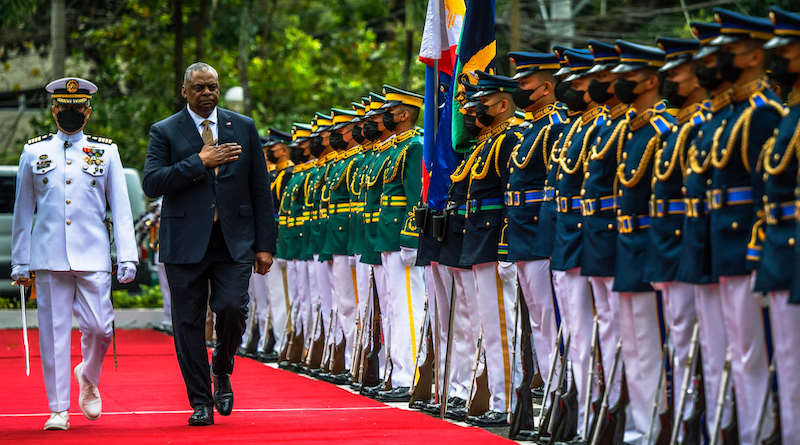US-Philippine Alliance Strengthens As It Enters New Phase
By DoD News
By Jim Garamone
U.S. service members will be doing a lot more training and exercises alongside their Philippine allies, as the defense alliance between the two nations continues to grow.
Secretary of Defense Lloyd J. Austin III travelled to Manila and met with Philippine President Ferdinand Marcos and Secretary of National Defense Carlito Galvez to chart the way forward for the treaty alliance between the Philippines and the United States.
During a meeting at the Malacanang Palace, Austin told Marcos that the United States wants to strengthen that relationship in every way possible. “You are a key ally and an important ally,” the secretary said. “And so, from the defense perspective, we will continue to work together with our great partners to build and modernize your capability as well as increase our interoperability.”
Marcos pointed to the security environment in the Indo-Pacific region during his meeting with Austin. “More specifically here, the Asia-Pacific region has become a terribly complicated situation,” he said. “It is something we can only navigate with the help of our partners and our allies.”
The United States and Philippines are treaty allies and have been since 1951 when the two countries signed the Mutual Defense Treaty. “It would be stating the obvious to say that our longest partner has been the United States,” Marcos said. He said the United States will remain — and should remain — a vibrant part of the region, because the United States is a Pacific power.
As Austin and Galvez left the palace to continue their discussions at the Department of National Security, the two nations announced that they planned “to accelerate the full implementation of the Enhanced Defense Cooperation Agreement with the agreement to designate four new agreed locations in strategic areas of the country and the substantial completion of the projects in the existing five agreed locations.”
U.S. officials were pleased with this announcement. They called the agreement a “pillar” of the U.S.-Philippine alliance. The agreement “supports combined training, exercises and interoperability between our forces,” the release said. “Expansion of the EDCA will make our alliance stronger and more resilient, and will accelerate modernization of our combined military capabilities.”
The release did not say which new locations would be in the agreement. The Philippine government would like time to speak to regional and local officials about the process before going public with the actual bases. The locations already in the agreement are Cesar Basa Air Base in Pampanga, Fort Magsaysay Military Reservation, Lumbia Air Base, Antonio Bautista Air Base and Mactan Benito Ebuen Air Base.
Austin and Galvez participated in a news conference at the end of their meeting. The two men worked on ways to strengthen and already strong alliance. “We conduct more than 500 defense engagements together every year,” Austin said. “And as President [Joe] Biden has made clear, America’s commitment to the defense of the Philippines is ironclad.”
The Philippines and the United States share common values and principles. “Our alliance makes both of our democracies more secure — and helps uphold a free and open Indo-Pacific,” the secretary said.
Galvez and Austin also reaffirmed the mutual defense treaty commitments. Austin said the Mutual Defense Treaty applies to armed attacks on either countries’ defense assets to include vessels and aircraft anywhere in the West Philippine Sea — the name the Philippines prefer to South China Sea.
“We discussed concrete actions to address destabilizing activities and the waters surrounding the Philippines, including the West Philippine Sea, and we remain committed to strengthening our mutual capacities to resist armed attack,” Austin said.
Austin and Galvez also spoke about modernizing Philippine military capabilities. Austin said these “efforts are especially important as the People’s Republic of China continues to advance its illegitimate claims in the West Philippine Sea.”
Austin said he is proud of the work that has gone into the effort to strengthen the alliance on both sides. “I am optimistic about the future of our alliance,” he said. “And I am confident that we will continue to work together to defend our shared values of freedom, democracy and human dignity. The United States and the Philippines are more than just allies. We’re family.”

